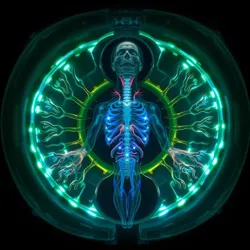Echo Chamber Beast
The Echo Chamber Beast (Sonus multiplicatus) is a highly specialized deep-sea creature known for its extraordinary ability to manipulate sound waves and create complex acoustic illusions in the hadal zone. This remarkable species has evolved sophisticated biological sonar systems that surpass any known natural echolocation capabilities.
 Anatomical diagram showing the intricate echo chambers of Sonus multiplicatus
Anatomical diagram showing the intricate echo chambers of Sonus multiplicatusPhysical Characteristics
The Echo Chamber Beast possesses a unique physiological structure consisting of multiple interconnected resonance chambers that run along its 12-15 meter length. These chambers, lined with specialized sound-reflecting tissue, allow the creature to amplify, redirect, and modify sound waves with remarkable precision.
Their most distinctive feature is the series of acoustic lens organs distributed across their body, which can focus and shape sound waves like biological acoustic mirrors. The beast's skin contains thousands of microscopic pressure-sensitive pores that help it detect and respond to minute changes in water pressure and sound waves.
Behavioral Patterns
These creatures are known for their sophisticated hunting strategy called sonic deception, where they create phantom sound signatures that confuse both prey and predators. They can generate multiple false acoustic images of themselves, effectively creating a hall of mirrors effect using sound waves.
The Echo Chamber Beast has been observed interfering with human sonar equipment by generating complex acoustic phantoms, leading to numerous misidentified readings in deep-sea exploration data. This ability serves as both a defensive mechanism and a hunting technique.
Habitat and Distribution
Primarily inhabiting depths between 7,000 and 9,000 meters, Echo Chamber Beasts show a preference for areas with specific acoustic properties, often choosing locations near underwater canyons and abyssal trenches that enhance their sound-manipulation abilities.
Research Challenges
Scientific study of the Echo Chamber Beast has proven particularly challenging due to their ability to confound traditional observation methods. The development of new quantum acoustic sensors has recently enabled more accurate tracking and observation of these elusive creatures.
See Also
- Deep Sea Acoustic Phenomena
- Phantom Sonar Signatures
- Biological Sound Manipulation
References
- Advanced Marine Bioacoustics Journal
- Hadal Zone Cryptid Studies
- Deep Ocean Sound Patterns Review